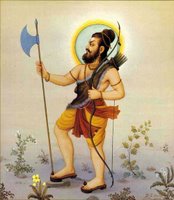 History on Parade: Kerala
History on Parade: KeralaOur journey to the southwest state of Kerala was filled with unexpected sounds and spectacles. Even though Kerala is one of the smallest Indian states (just 1.3% of the Indian land mass), it has a history rich in legendary lore and historic fact.

Legend recounts that the slender state of Kerala was created by an act of penance performed by Lord Vishu, who had descended from the heavens in his incarnation of Parashuram. Parashuran waged a terrible war against the evil kings of the land, killing them 21 times. The legend continues that Parashurama was so struck by remorse at his wanton killings he offered to perform a penance. The sea god Varuna responded and offered him land equal to the distance he could throw his axe. Parashurama threw his axe from northern tip of Kerala in Gokarnam and it fell at Kanyakumari at the southern tip of India. As promised, the sea gave way to land, thus giving rise to Kerala.
 With terra firma provided by the gods, mortals of the world traveled to Kerala to trade and prosper. The Phoenicians arrived about 1000 B.C. In the coastal city of Cohin, a Jewish synagogue stands in testament to the early arrival of these traders. Even today, Jew Town, as it is called, is an open market of commerce. The Apostle Thomas is said t
With terra firma provided by the gods, mortals of the world traveled to Kerala to trade and prosper. The Phoenicians arrived about 1000 B.C. In the coastal city of Cohin, a Jewish synagogue stands in testament to the early arrival of these traders. Even today, Jew Town, as it is called, is an open market of commerce. The Apostle Thomas is said t o have arrived here in 52 A.D.
o have arrived here in 52 A.D.In the 1400’s, the intrepid Portuguese, lead by Vasco da Gama, along with the Dutch and then the British, landed in Kerala and inaugurated centuries of
 European contact with the inhabitants of Kerala. In our western history, Kerala is known as the Malabar Coast.
European contact with the inhabitants of Kerala. In our western history, Kerala is known as the Malabar Coast.We visited the church where da Gama’s body laid for 12 years before being returned to Portugal, toured an old Dutch house and exchanged pleasantries in English with our local innkeeper. While visiting the remnants of former European contacts, we were also treated to the alive and rich Southern Indian culture.

A highlight of our trip was seeing a performance of a 500 year old traditional dance called Kathakali. In Kathakali, men have devoted years to learning facial and hand expressions, music, singing and dance to retell stories from the Hindu epics Mahabharatha and Ramayana. Attendees were invited to watch the application of the make-up before the show. The 90 minute performance we saw was spectacular.


Our Kerala adventure included both theater and street drama. As we drove the back roads of Kerala, we discovered the road was blocked by a huge festival (audio) par
 ade. The parade was complete
ade. The parade was complete  with elephants, musicians (video), men in faux trances, men twirling tall colorful whirligigs (video) and flowers everywhere, al
with elephants, musicians (video), men in faux trances, men twirling tall colorful whirligigs (video) and flowers everywhere, al l accompanied by a throng of townspeople in tow. We were, and remain today, completely ignorant of the reason for the festival. For us it was another foreign fragment of Indian culture to be reconciled with the other fragments we gather each day.
l accompanied by a throng of townspeople in tow. We were, and remain today, completely ignorant of the reason for the festival. For us it was another foreign fragment of Indian culture to be reconciled with the other fragments we gather each day.

0 Comments:
Post a Comment
<< Home